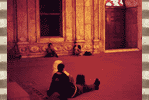 |
 |
 |
|
|||
|
the Minarets of Cairo Within a decade of the founding of Islam in 632 A.D., Egypt's Muslim conquerors established Cairo's first mosque on the east bank of the Nile. Others quickly followed at the amazing rate of about one every five to ten years, right on through the end of the 19th century. 
Five times a day, the voice of the prayer caller, or muezzin, continues to ring out across Cairo's hazy skyline, summoning the faithful to worship and reminding them that, according to the first of Islam's five pillars, there is no God but Allah, and Mohammed is his prophet. Among the mosques high on the list of many visitors to Cairo is that of Sultan Mohammed Ali. An autocratic Albanian, Mohammed Ali took over after French colonial troops abandoned Egypt around the turn of the 19th century. Like the former heavyweight boxing champ who would one day adopt his name, Mohammed was no shrinking violet. A man with little use for diplomacy, he assumed power by inviting his enemies to a banquet where he proceeded to have them slaughtered. Not far from the sight of this massacre, atop the city's highest hill, he erected his mosque, an everlasting shrine to himself.
Touring Egypt in 1874, British travel writer Amelia Edwards was less than impressed with the sultan's efforts. 
She did, however, enjoy the view from the terrace, as did I, with a copy of her book in hand to compare notes. Edwards and I both preferred the elegant tranquility of the 14th century Sultan Hassan mosque. Here, robed caretakers sweep the courtyard with palm branches. Birds twitter about the fountain where worshipers cleanse themselves before prayers.
The tomb of the Sultan himself lies beyond in the liwan, or sanctuary, a richly decorated chamber, famous for its acoustics which the resident muezzin will demonstrate for a meager tip. 
The slender tower, or minaret, of the Sultan Hassan mosque is just one of thousands rising above the jumbled streets of the city. Their density has inspired many a poet throughout history to compare Cairo's skyline to a forest. While today the calls of the muezzin broadcast from these towers are, more often than not, prerecorded, there's a timelessness to their haunting unity, especially in the early morning hours as this ancient city begins yet another day as it has for centuries... in prayer. In Cairo, I'm Tom Verde for The Savvy Traveler
|
 | American Public Media Home | Search | How to Listen ©2004 American Public Media | Terms of Use | Privacy Policy |
